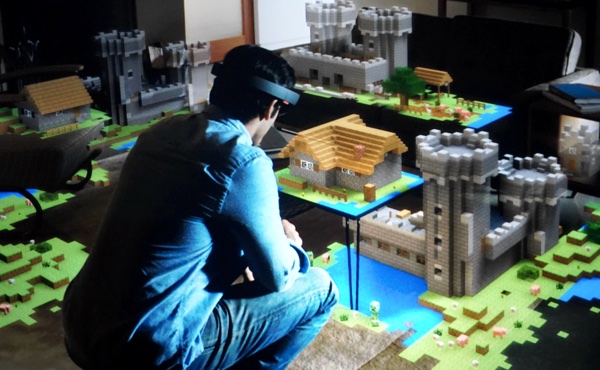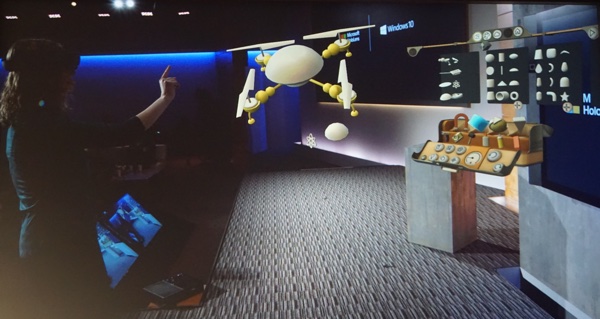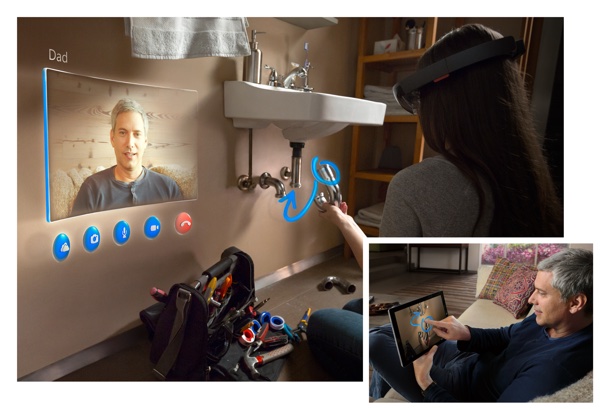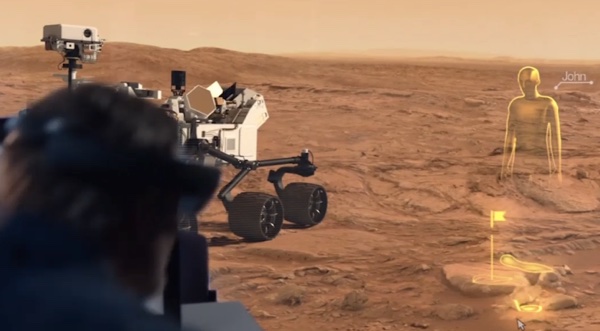HoloLens Hands-on: Microsoft Leapfrogs Apple in Innovation
After experiencing a series of mind-bending HoloLens demos, it's clear that Microsoft has the most ambitious vision yet for computing's future.

Bellevue -- As I walked away from my first experience with HoloLens, I couldn’t help but think that Microsoft had just overtaken Apple in terms of imagining the future of technology. I walked on the surface of Mars, blew a hole in a real-world wall -- and saw right through it -- while playing Minecraft and installed a light switch while a digital helper drew on my field of vision via Skype. This was more than augmented reality or virtual reality. It was a new reality altogether.
Although the holographic headset I played with wasn’t nearly as sleek as what was shown on stage at Microsoft's press event (we test drove a clunky dev kit), HoloLens could transform everything from education and entertainment to home improvement and medicine. And I’m sure I’m missing some possibilities here. Here’s a recap of my time with HoloLens, and my take on where it could go.
Editors’ Note: Microsoft didn’t permit hands-on photos in the Hololens demo area. The images here are supplied by the company or were taken during the keynote presentation on Microsoft's campus.
How HoloLens Works
The protoype HoloLens I tested consisted of a headset attached to a chunky box that you wear around your neck that houses the CPU, GPU and HPU (holographic processing unit). It allows the device to process terrabytes of data from the glasses' sensors in real time. In the final version, all of the components will be housed in the glasses. Although I couldn't touch the final design, I noted a pair of buttons on the top of each side, speakers on the underside of each side, and what looked like a microUSB port in the back (presumably for charging).

There's a depth camera in the glasses that has a field of vision of 120 by 120 degrees. That way, the device can better sense your hand movements. I found that I had no problem seeing through the glasses, and that they didn't limit my peripheral vision. Before using the prototype, Microsoft needed to measure the interpupillary distance or IPD (the distance between my eyes) and enter the number into a connected PC, but the company says the final glasses will be able to do this step all on its own.
HoloLens features see-through, holographic lenses and spatial sound so you can see and hear holograms in your environment. According to Microsoft's definition, the holograms you see are made of light and can be 2D or 3D. Depending on the applicaiton, you can also move the holograms, reshape them or change their color. As I found out, HoloLens also makes it possible for holograms to interact with the real world.
Minecraft Smashes Into Your Living Room
My kids are much bigger Minecraft fans than I am, but I was still blown away by my first taste of HoloLens. Using spatial mapping, the developer kit allowed me to see a Minecraft world overlaid on top of a coffee table and other furniture.
Get instant access to breaking news, the hottest reviews, great deals and helpful tips.

I could call up items, like a shovel, using just my voice, allowing me to dig a hole in part of a table to prevent zombies from attacking my tower. All I needed to do to dig was air tap, which means aiming your eyes at an object and then executing a downward motion with your finger.
The coolest part of this demo came when I lit some TNT next to a wall. After the explosion, I could then peer through the resultant hole, out of which bats flew. As I stared down through the coffee table where I had dug a hole earlier, I could see digital lava on the floor. That's nuts.
MORE: Samsung Gear VR Review - Virtual Reality with a Smartphone
Holobuilder: Creating 3D Objects Out of Thin Air

Creative types will be thrilled with the Holobuilder, an experience that allows you to build virtual 3D objects and then share them or print them. I wasn’t allowed to drive this demo, but I appreciated the ease with which someone could assemble a koala bear using a series of shapes. I especially like the little touches, like hearing the spray paint can sound when applying colors to objects.
Microsoft has found clever ways to integrate speech as well. While putting together a virtual toy truck, the presenter said “Copy” to recreate the tire assembly as he walked around the hologram. Equally impressive, using the resizing tool, he could make objects smaller by moving his head in one direction or bigger by moving it in another direction.
Even if you’re not into 3D printing, there’s still a nifty way to share your final creation. You can snap a photo of your object sitting next to a real live person.
Most Surreal Skype Call Ever
The days of me getting out of home improvement projects because I’m not handy are numbered. During my favorite HoloLens demo, a Skype caller walked me through installing a light switch step by step, literally drawing on my environment to point out what tools or objects to pick up and how to use them.

I could see the other caller's face, and I could even pin it to stay in one place on the wall so I could go back to it at any time, or have her head follow me around. As it turns out, pinning her to one spot made sense, so she could highlight exactly how I should pick up items in order to install them properly, as well as use a tool to check for voltage in the wires.
There’s so much potential for HoloLens applications like this for the likes of Home Depot or Lowe’s or Ikea. You get the instruction you need without having someone come to the house -- or shifting your gaze between what you're working on and instructions or YouTube videos. But there’s all sorts of other possible uses. Imagine a specialist literally walking a surgeon through a critical procedure from around the world.
Mars Visit via OnSight: You’re Now Rover
When NASA’s Jet Propulsion Laboratory decides to embrace your tech, you know you’re on to something. I walked around the surface of Mars, bending down to take a look at a rock that may provide clues to an earlier wet history for the planet.

I also collaborated with a remote JPL scientist, who helped me take higher-resolution photos of a mountainous region with a few air taps. During our interaction, I could see his bright green avatar (which looked more like the outline of a human than the real thing), as well as what he pointed to as we chatted.
The point of this demo is that HoloLens can accelerate the pace of exploration and study. JPL claims that it will be able to control rovers on Mars via this technology by July.
Outlook: Extremely Exciting and Promising
Cortana on the desktop and Xbox game streaming to your PC are nice iterative steps for Windows 10, but HoloLens is a huge leap forward for the company. It proves that Microsoft can be just as ambitious as Apple, Google or any tech startup. In fact, I tweeted right after my demos that Microsoft packed more innovation into this one unveiling than three Apple events put together.
My mind is now racing thinking about the ecosystem Microsoft and its partners could build. This is a platform that could be just as practical as it is exciting, solving real-world problems by combining the digital and physical.
To be clear, this is not a device I would use out in the street, but it’s not designed to be Glasshole 2.0. HoloLens is meant to be used at home or in the workplace. I do have other concerns, though, such as how long the battery will last. After all, the final hardware will have a CPU, GPU and new dedicated Holographic processing unit inside. I also wonder how long it will take Hololens to spatially map out your environment on the fly, and, of course, how much it will cost.
Nevertheless, based on my early impressions, HoloLens has the potential to be an incredibly empowering platform. Your move, Apple.
- HP's Virtual Reality Display Blows Our Minds
- Best Fitness Trackers on the Market
- Most Anticipated Games
Mark Spoonauer is editor in chief at Tom's Guide. Follow him at @mspoonauer. Follow Tom's Guide at @tomsguide, on Facebook and on Google+.
Mark Spoonauer is the global editor in chief of Tom's Guide and has covered technology for over 20 years. In addition to overseeing the direction of Tom's Guide, Mark specializes in covering all things mobile, having reviewed dozens of smartphones and other gadgets. He has spoken at key industry events and appears regularly on TV to discuss the latest trends, including Cheddar, Fox Business and other outlets. Mark was previously editor in chief of Laptop Mag, and his work has appeared in Wired, Popular Science and Inc. Follow him on Twitter at @mspoonauer.
-
Merry_Blind Wow I was skeptical at first but this is very impressive! Can't believe Microsoft actually created something revolutionary that seems to work for once! Can't wait to see the bright future of this device!Reply -
Giroro This concept completely and irrevocably lost me at voice control. Microsoft (and a the rest of the industry) has been working on that for, what, 15 years without getting it to work consistently?Reply
Also, anything relating to the exploration of Mars is basically fiction. There is several minutes of delay between sending a command and the transmission arriving at that planet that can never be fixed. And even then, all you can get back from current rovers are relatively low res still images. . . and a lot of scientific data best viewed in a text editor.
-
waltfrench <i>“I couldn’t help but think that Microsoft had just overtaken Apple in terms of imagining the future of technology.”</i>Reply
I'm not sure Apple ever had the crown. Where they have excelled—and where Microsoft has been lagging—is in bringing real products that real people will buy and enjoy.
HoloLens, which is demo ware in a field that MANY OTHERS (Google Glass, Jaunt, Occulus, …) have been toiling, *IS* a nice extension of their Kinect efforts to add more virtuality. Disruptive of the incumbents? Not at all.
Maybe the most telling is that I have yet to see any of them dismiss HoloLens as immature, or saying “Microsoft just doesn't get it.” They're simply not threatened but instead have work to do to build the field. -
Afion I work for a major European car manufacturer and we recently opened our first factories in China. Because the Chinese technicians have not yet all the technical knowledge needed to solve all the breakdowns in the factory, we have put a system in place where they have head mounted camera's sending real-time video to a technician or engineer in Europe and they then give auditory support to the person.Reply
This system does not work as well as expected because of the language barriers being worse than what we thought. Having the possibility to give visual input like explained in the article would be a major improvement.
I can definitely see a lot of different uses for a system like this in a factory environment. -
burningdragons Ok guys just letting you know this technology is real and will be coming relatively soon. BUT it will not look like the images shown. To calculate the polygons in VR scenes like the minecraft or space one you would need a lot of processing power. However things like the video chat (without the tablet guy bs) or the stage demo would be capable on current hardware (if you had the wallet). Just don't get TO hyped for this technology thinking hololens is going to give you the holodeck from Star Trek. Also this http://www.wired.com/2015/01/magic-leaps-vision-for-virtual-reality/Reply -
falchard Apple is not an Innovative company. They are a marketing and hype generator for redesigning existing innovations. Microsoft is one of those companies that does innovate which Apple redesigns from. For instance the Tablet PC and... a windows based computer.Reply
This seems ... cool. VR is nice, but this is like an overlay on reality. Won't need a GPS for my car now. -
matt Storm In regards to the google voice for cell service I'm able to make calls on my nvidea shield tablet of att which it came with however i tested it on my droid razor and it came in fine for phone callsReply -
rokit Just because someone said "i saw it and its awsome" doesn't mean anything because thats how marketing works.Reply
"The protoype HoloLens I tested consisted of a headset attached to a chunky box that you wear around your neck that houses the CPU, GPU and HPU (holographic processing unit)"
What kind of box there must be to make their trailer show a reailty?
Again people don't be fooled, sure minecraft stuff is possible but scanning motocycle and being able to model it is bullshit right there. Just look at the devices that are used in the industry, their size, time they took to capture everything and time to ploish the fro final presentation.
And the part with Apple innovating is kind of strange, could list any innovation done by Apple? They were always a marketing company, they sell the same stuff you can bye from others or gather parts yourself. The only reason you might think they were the reason some tech existed because of them is that you don't follow other companies. Apple simply takes the newest technology that is too pricy for mass production and slaps apple logo on it while naming it differently.

